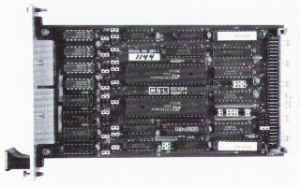VME404

VME 404 3U VME bus Serial Card
- Four Asynchronous/Synchronous Channels
- Two Z8530 Serial Communications Controllers
- Transmit and Receive Clock and Modem Control Signals
- Two Fully Buffered RS-232 Channels
- Two Fully Buffered RS-485/422 Channels
- Multi-point Communication on Each RS-485 Channel
- Multi-protocol Capability Including Asynchronous, HDLC, and SDLC
- Programmable Baud Rate Generators
- NRZ, NRZI, FM1, FM0, and Manchester Data Coding with Digital Phase Locked Loop Decoding
- Data Rates up to 38.4 Kbps (Asynchronous) or 614 Kbps (Synchronous) Limited Only by Processor Servicing
- VMEbus Slave Access: A16:D8, 32 Bytes, Configurable Address
- VMEbus Vectored Interrupts on Any Level
The VME404 Four Channel Serial Communications card provides four versatile, independent channels. All four channels are identical except that two are buffered for RS-232 interfaces and two for RS-422/485 interfaces. Micro-Link also offers similar cards with four RS-232 channels (VME403) and four RS-422/485 channels (VME401).
The Zilog Z8530 SCC (Serial Communication Controller) supports the popular asynchronous and synchronous data communication protocols. It includes doubled buffering for each transmit channel and quadruple buffering on each receiver.
Asynchronous capabilities include full and half duplex operation, 5 through 8 data bits, even/odd/no parity, 1, 1.5, 2 stop bits, frame/overrun/parity error detection, break generation and detection, and full modem handshake with program or automatic control.
Synchronous capabilities support bit and byte orientated protocols. Synchronous character recognition may be internal or external; one or two 6 or 8 bit internal synchronous characters can be supported. Both generation and checking algorithms for common CR (Cyclic Redundancy Check) are provided.
When operating with bit synchronous modes such as SDLC and HDLC, the SCC performs zero bit insertion and deletion, I-field residue handling, inserts flag sequences between messages, and handles abort sequences and address field recognition as well as CRCs.
On the VME404, the SCC can support bit rates up to 1 Mbps, depending on the data encoding/decoding. The actual data rate that can be used will be limited by the ability of the CPU card and software to service the SCC and not by the VME404 card itself. Data encoding can be used with any protocol, and the digital phase locked loop can recover the data clock from a suitably encoded incoming data stream.
The RS-485 buffering is fully compatible with RS-422 and additionally provides contention protection when several transmitters share a communication link. Each RS-485 channel allows up to 32 driver/receiver pairs on a common data bus. The drivers and receivers for each RS-485 channel on the VME404 may be enabled or disabled under software control. The common mode range is -7 volts to +12 volts with power on or off.
Each SCC can generate a VMEbus interrupt to indicate that servicing is required. When a VMEbus interrupt is acknowledged, the SCC will return a vector to identify the interrupt condition and direct the CPU to the appropriate service routine. Each channel provides four different vectors for normal receive data available, special receive data available, transmit buffer empty, and external/status change. The interrupts from the VME404 can be directed to any one of the seven VMEbus interrupt request levels.
The VME404 occupies 16 consecutive odd byte locations in the VMEbus short I/O address space. Jumpers select the base address for the card and whether the card responds to the Supervisory access mode or to both Supervisory and Non-Privileged access modes.
- Environmental
- Operating Temperature: 0 to 65°C
- Maximum Operating Humidity: 90% Non-Condensing
- VME Bus Data Access: A16:D8 Slave
- VME Bus Interrupt: Any One of Seven Priority Levels (IRQ1-IRQ7)
- Power Requirements
- 1.5 A maximum (975mA typical) at +5 VDC, ± 5%
- 100 mA maximum (60 mA typical) at +12 VDC, ± 5%
- 100 mA maximum (60 mA typical) at -12 VDC, ± 5%
